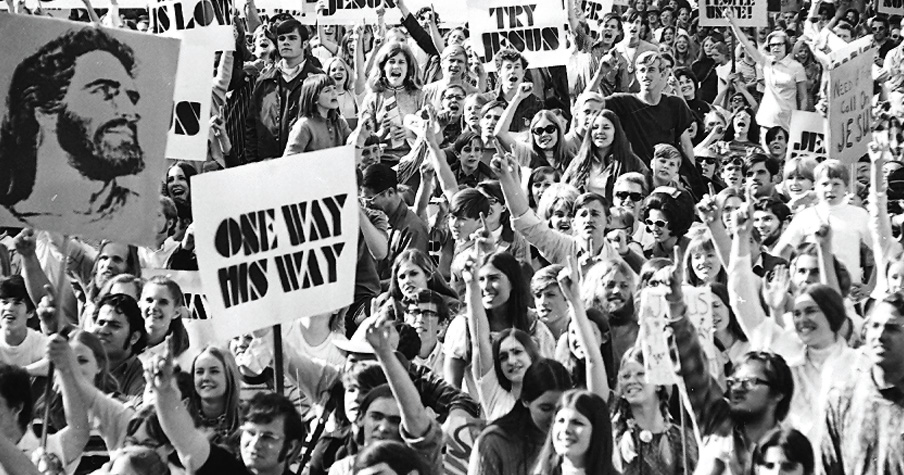
A crowd of young adults at Sacramento Spiritual Revolution Day in 1971 are emblematic of the Jesus Movement, as pictured then by the Hollywood Free Paper. Photo Made available by Fuller Theological Seminary
The summer’s here, and the beach is calling—just as it did half a century ago when the Jesus Movement was making inroads everywhere, from coffeehouses and music festivals to homes and schools. Perhaps the most iconic place to find self-identified “Jesus People” was along southern California’s Pacific coast, where crowds regularly gathered to pray and celebrate baptism. In its cover story from June 21, 1971, Time magazine reported on mass baptisms at a beach in Corona del Mar, California:
“Under a setting sun, several hundred converts waded into the cold Pacific, patiently waiting their turn for the rite. On the cliffs above, hundreds more watched. Most of the baptized were young, tanned and casual in cut-off blue jeans, pullovers and even an occasional bikini. A freshly dunked teenager, water streaming from her tie-dyed shirt, threw her arms around a woman and cried, ‘Mother, I love you!’ A teen-age drug user who had been suffering from recurring unscheduled trips suddenly screamed, ‘My flashbacks are gone!’ As the baptisms ended, the crowd slowly climbed a narrow stairway up the cliff, singing a moving Lord’s Prayer in the twilight.”

The celebrant at this event, Rev. Chuck Smith of Calvary Chapel in Costa Mesa, was one of the movement’s early and enduring leaders. He had seen disaffected young people dabble with and fall headlong into the hippie subculture that many in “establishment” congregations found objectionable. Smith welcomed them to his church, and soon the congregation grew to a few thousand. In the following decades, Calvary Chapel expanded from a single congregation to a network of 1,800.
Grassroots groups around the United States and Canada tapped into a new spirit that offered solace for people who struggled with the harsh reality of a society that felt hollow and broken. Framing Jesus as a countercultural rebel, a radical peacemaker, and a transcendent and personal savior captured their imagination. Copies of their underground newspaper Hollywood Free Paper and The Jesus People magazine found their way to all 50 states and beyond.
The Time article said the Jesus Movement was “something more lasting than a religious Woodstock,” and that came to pass. The movement impacted Christian groups of nearly every stripe. From the development of worship music to the focus and approach of parachurch organizations, the Jesus Movement made for a watershed moment.